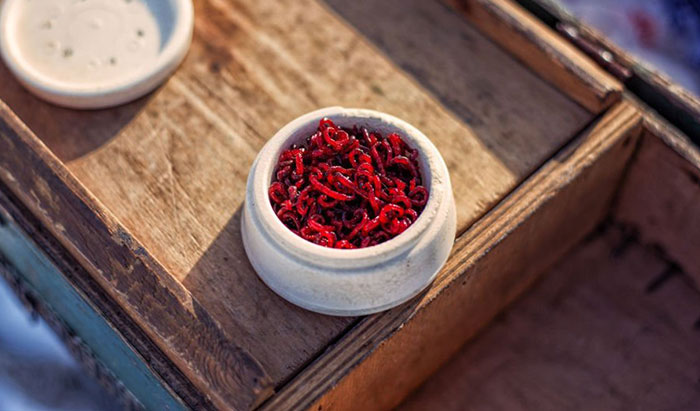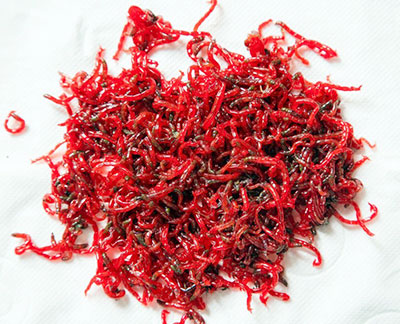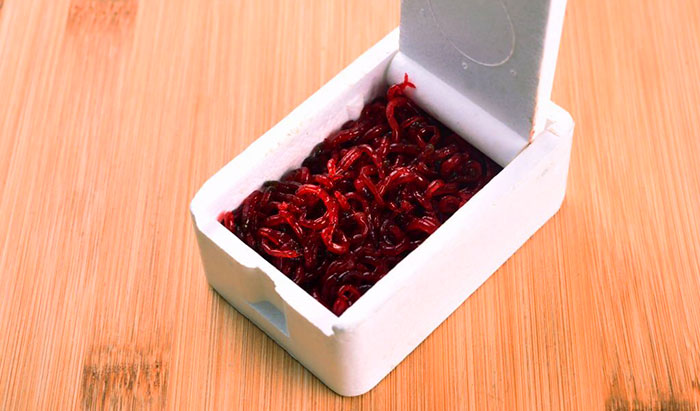Bloodworms are considered one of the primary foods that meat-eating fish will consume inside the aquarium. This fish food usually comes live, frozen, or freeze-dried and brings nutritional benefits to the fish. Many hobbyists have opted to feed their fish with frozen bloodworm as they are more convenient and last longer, especially when kept in the freezer.
But how to feed frozen bloodworms? You can either mass feed or target feed those bloodworms when feeding to all of your fish. The number of bloodworms and the type of preparation you will do in feeding bloodworms to your fish will be discussed below.
What to Prepare:
- Frozen Bloodworm
- Hand Gloves
- Container
- Tweezers
- Net (For Cleaning)
Step 1: Determining the Correct Amount of Bloodworms
The initial step is to determine the amount of bloodworms you will give your fish in the aquarium. The actual amount will largely depend on the size of the aquarium and the number of fish you own. Although, a good guide is to give not more than anything that the fish can eat in a span of 3 minutes.
The correct amount is crucial because giving more will make the fish overeat, or excess food will remain in the water. This extra amount can contaminate and harm the fish in the future. There are many ways to determine the right amount of food you will give, such as following the instructions in the product packaging or asking advice from fish-keeping professionals.
Doing a Feeding Test
Another way to determine the correct amount of bloodworms to give to your fish is to do a feeding test. This test can be done by feeding your fish in small increments using a plastic spoon or a fork. Keep on feeding the fish until you feel satisfied with the amount of bloodworms you give.
After feeding the fish, you need to keep track of the amount of bloodworms given to the fish. You can check on the remaining frozen bloodworms to determine the amount you have provided. This amount will be the basis for your next feeding activity.
Step 2: Determining the Frequency of the Feeding
After determining the correct amount of bloodworms to be given, the next thing to know is to determine the frequency of your feeding activity with bloodworms. Again, the frequency will largely depend on the type of fish inside the aquarium.
If you own cold water fish, they have the tendency to eat more foods than they need in their body. Nocturnal fish also has different requirements, which should be considered if you own one.
Check the water quality to check if you are giving too much food to the fish. Suppose the quality of the water has deteriorated. In that case, that is a signal for you to reduce your feeding frenzy since it is a sign o uneaten foods that accumulate inside the aquarium.
Step 3: Food Preparation
When learning how to feed axolotl frozen bloodworms or any other type of bloodworms, you should know that Bloodworms need to be prepared before it is served to the fish. I heard other hobbyists directly serving frozen bloodworms to the fish, but this way is not applicable to all, especially to those fish species that are sensitive to temperature changes. Unfortunately, frozen bloodworms can change the water’s temperature when put in the aquarium water directly.
The best step is to prepare the frozen bloodworm by thawing it before serving it to the fish. You can use a container filled with aquarium water to thaw the frozen bloodworm. It will only take a few minutes to unfroze the bloodworms and should be ready to be given to the fish.
Step 4: Feeding the Fish
Once the frozen bloodworm is already prepared, you can now start feeding it to your fish. Depending on your feeding goals, you can do mass feeding or target feeding. If you are confident that the bloodworm you prepared will be fully consumed, the entire amount of bloodworm can be poured across the tank.
This step must be done to get equal distribution inside the aquarium. However, if you feel that some fish are not getting their fair share of food, then target feeding can be done. You can use tweezers or any other tools to feed a fish separately.
Step 5: Cleaning After Feeding
After feeding the fish, you must clean your aquarium of all the uneaten bloodworms. Wait for about 5 minutes before starting the cleaning process. This step is crucial as that uneaten food can contaminate the water if not removed. As for those extra bloodworms, keep them in the fridge for future use.
Contents
How Long Do Bloodworms Last in the Fridge
Many fish tank owners like to feed frozen bloodworms with the food’s ability to last for a long time. But how long? A bloodworm will last for about three months if they stay in the freezer. If they are only inside the fridge, they should last around 3 to 4 days.
The longevity of the bloodworms also depends on the type of cold storage you will use in your fridge. If you own a freezer with an auto defrost cycle feature, try to feed the bloodworms within one month. The bloodworm should last for about three months or probably more for freezers without an auto defrost cycle, such as a chest freezer.
Conclusion
Bloodworm is an excellent food option for your fish but learning how to feed frozen bloodworm is a must should you decide to use it for your fish. This fish food is popular because o its convenience and longevity, but you must have the proper storage for this food to last longer.



